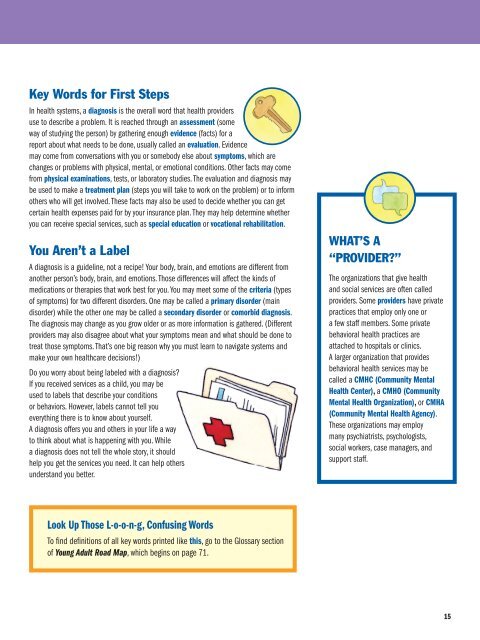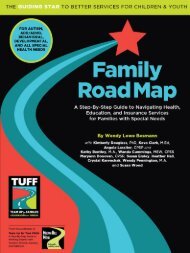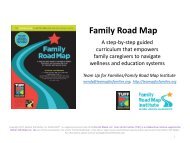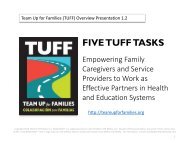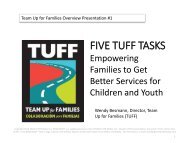Look Inside Young Adult Road Map
Create successful ePaper yourself
Turn your PDF publications into a flip-book with our unique Google optimized e-Paper software.
Key Words for First Steps<br />
In health systems, a diagnosis is the overall word that health providers<br />
use to describe a problem. It is reached through an assessment (some<br />
way of studying the person) by gathering enough evidence (facts) for a<br />
report about what needs to be done, usually called an evaluation. Evidence<br />
may come from conversations with you or somebody else about symptoms, which are<br />
changes or problems with physical, mental, or emotional conditions. Other facts may come<br />
from physical examinations, tests, or laboratory studies. The evaluation and diagnosis may<br />
be used to make a treatment plan (steps you will take to work on the problem) or to inform<br />
others who will get involved. These facts may also be used to decide whether you can get<br />
certain health expenses paid for by your insurance plan. They may help determine whether<br />
you can receive special services, such as special education or vocational rehabilitation.<br />
You Aren’t a Label<br />
A diagnosis is a guideline, not a recipe! Your body, brain, and emotions are different from<br />
another person’s body, brain, and emotions. Those differences will affect the kinds of<br />
medications or therapies that work best for you. You may meet some of the criteria (types<br />
of symptoms) for two different disorders. One may be called a primary disorder (main<br />
disorder) while the other one may be called a secondary disorder or comorbid diagnosis.<br />
The diagnosis may change as you grow older or as more information is gathered. (Different<br />
providers may also disagree about what your symptoms mean and what should be done to<br />
treat those symptoms. That’s one big reason why you must learn to navigate systems and<br />
make your own healthcare decisions!)<br />
Do you worry about being labeled with a diagnosis?<br />
If you received services as a child, you may be<br />
used to labels that describe your conditions<br />
or behaviors. However, labels cannot tell you<br />
everything there is to know about yourself.<br />
A diagnosis offers you and others in your life a way<br />
to think about what is happening with you. While<br />
a diagnosis does not tell the whole story, it should<br />
help you get the services you need. It can help others<br />
understand you better.<br />
What’s a<br />
“Provider?”<br />
The organizations that give health<br />
and social services are often called<br />
providers. Some providers have private<br />
practices that employ only one or<br />
a few staff members. Some private<br />
behavioral health practices are<br />
attached to hospitals or clinics.<br />
A larger organization that provides<br />
behavioral health services may be<br />
called a CMHC (Community Mental<br />
Health Center), a CMHO (Community<br />
Mental Health Organization), or CMHA<br />
(Community Mental Health Agency).<br />
These organizations may employ<br />
many psychiatrists, psychologists,<br />
social workers, case managers, and<br />
support staff.<br />
<strong>Look</strong> Up Those L-o-o-n-g, Confusing Words<br />
To find definitions of all key words printed like this, go to the Glossary section<br />
of <strong>Young</strong> <strong>Adult</strong> <strong>Road</strong> <strong>Map</strong>, which begins on page 71.<br />
15


